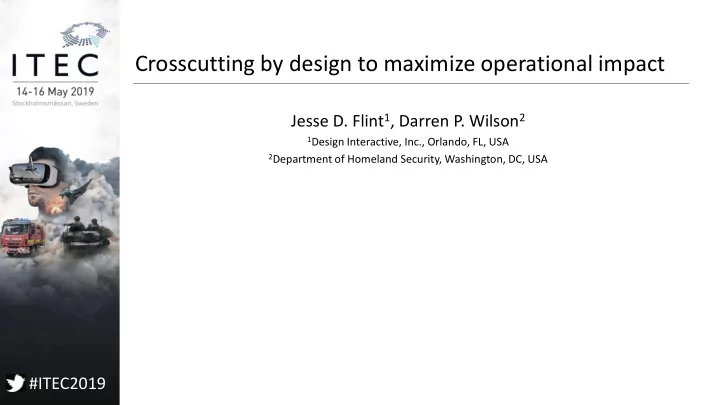

Crosscutting by design to maximize operational impact Jesse D. Flint 1 , Darren P. Wilson 2 1 Design Interactive, Inc., Orlando, FL, USA 2 Department of Homeland Security, Washington, DC, USA #ITEC2019
Need for crosscutting solutions • The United States Department of Homeland Security (DHS) is comprised of a broad range of components • Diverse needs and priorities • The Science and Technology Directorate (S&T) strives to address capability gaps across a range of components • Focus on shared interests and responsibilities • Need to meet crosscutting as well as component- specific needs #ITEC2019
Strategic and transparent engagement • Office of Innovation and Collaboration • Conduit to broad range of stakeholders o Range of DHS components o Other government agencies o Industry o Foreign partners o Academia • Develop in-depth crosscutting understanding of needs • Develop shared funding opportunities #ITEC2019
Solution development framework Capture User Needs End user engagement utilizing cognitive walkthroughs, focus groups, attending training sessions, reviewing existing training materials, and conducting stakeholder interviews Generate Training Requirements Identification of operational needs and capability gaps with consensus and high priority requirements with components Continual Stakeholder Engagement Iterative design where requirements, wire frames, prototypes, scripts, etc. are validated with stakeholders. Continual input from stakeholders assures that the final product will meet all needs Transition Components take possession of solution and begin operational use of the solution Post Transition Performance Assessment (PTPA) Each solution engages in an evaluation, whether from user interaction and acceptance studies or training effectiveness #ITEC2019 evaluations
Capture User Needs • United States Border Patrol (USBP) required tracking/signcutting training to track and apprehend aliens and smugglers • Federal Law Enforcement Training Centers (FLETC) required tracking/signcutting training to support missions ranging from search and rescue to crime scene analysis #ITEC2019
Capture User Needs • Reviewed training materials and observed training from both components • Conducted operational observations at 3 USBP sectors • Conducted knowledge elicitation interviews with signcutting experts #ITEC2019
Generate Solution Requirements • Defined learning objectives • Defined content platforms • Web enabled for basic concepts • 3D video for advanced concepts #ITEC2019
Continual stakeholder engagement • All stakeholders encouraged to participate in bi- weekly meetings • Establish common training needs across components • Review iterative design project milestones o Gap analysis o Learning objectives o Storyboards o Scripts o Alpha version #ITEC2019
Transition • Final solution of one funded project will benefit • All newly hired USBP Agents • Federal, State, Local, and Tribal law enforcement officers • No last minute changes requested by any stakeholders • Feedback of all stakeholders already integrated #ITEC2019
Post Transition Performance Assessment • Pilot study used to evaluate experimental feasibility (i.e., time, costs, training impact) before conducting full-scale study • Small group study • Do not expect statistically significant results • USBP Agent Trainees (BPATs) demonstrated 63% improvement in applications, analysis, and synthesis • Based on pilot study results, full scale PTPA will be conducted #ITEC2019
Conclusions • Involvement from stakeholders and end users from multiple components must begin at the start of projects to maximize benefits of the process. • Maintaining stakeholder and end user engagement is a challenge that requires constant attention and patience. • Iterative design with stakeholder and end user involvement reduces risks/surprises/unknowns and reduces last minute change requests as design is finalized and increases the probability that the design will be acceptable to the customer and/or end user and successfully transition to operations. • Balancing the crosscutting need with component-specific needs often requires obtaining consensus across components to prioritize requirements. • Post transition performance assessments results in wider solution adoption across multiple components, maximizing the impact of the investment. #ITEC2019
Recommend
More recommend